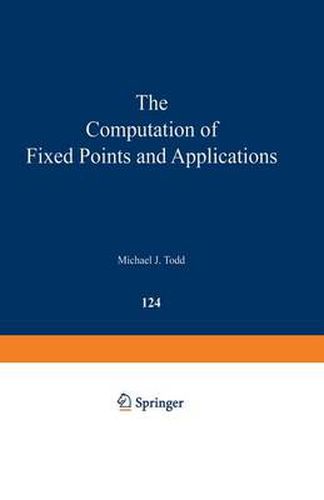Readings Newsletter
Become a Readings Member to make your shopping experience even easier.
Sign in or sign up for free!
You’re not far away from qualifying for FREE standard shipping within Australia
You’ve qualified for FREE standard shipping within Australia
The cart is loading…






This title is printed to order. This book may have been self-published. If so, we cannot guarantee the quality of the content. In the main most books will have gone through the editing process however some may not. We therefore suggest that you be aware of this before ordering this book. If in doubt check either the author or publisher’s details as we are unable to accept any returns unless they are faulty. Please contact us if you have any questions.
Fixed-point algorithms have diverse applications in economics, optimization, game theory and the numerical solution of boundary-value problems. Since Scarf’s pioneering work [56,57] on obtaining approximate fixed points of continuous mappings, a great deal of research has been done in extending the applicability and improving the efficiency of fixed-point methods. Much of this work is available only in research papers, although Scarf’s book [58] gives a remarkably clear exposition of the power of fixed-point methods. However, the algorithms described by Scarf have been super~eded by the more sophisticated restart and homotopy techniques of Merrill [~8,~9] and Eaves and Saigal [1~,16]. To understand the more efficient algorithms one must become familiar with the notions of triangulation and simplicial approxi- tion, whereas Scarf stresses the concept of primitive set. These notes are intended to introduce to a wider audience the most recent fixed-point methods and their applications. Our approach is therefore via triangu- tions. For this reason, Scarf is cited less in this manuscript than his contri- tions would otherwise warrant. We have also confined our treatment of applications to the computation of economic equilibria and the solution of optimization problems. Hansen and Koopmans [28] apply fixed-point methods to the computation of an invariant optimal capital stock in an economic growth model. Applications to game theory are discussed in Scarf [56,58], Shapley [59], and Garcia, Lemke and Luethi [24]. Allgower [1] and Jeppson [31] use fixed-point algorithms to find many solutions to boundary-value problems.
$9.00 standard shipping within Australia
FREE standard shipping within Australia for orders over $100.00
Express & International shipping calculated at checkout
This title is printed to order. This book may have been self-published. If so, we cannot guarantee the quality of the content. In the main most books will have gone through the editing process however some may not. We therefore suggest that you be aware of this before ordering this book. If in doubt check either the author or publisher’s details as we are unable to accept any returns unless they are faulty. Please contact us if you have any questions.
Fixed-point algorithms have diverse applications in economics, optimization, game theory and the numerical solution of boundary-value problems. Since Scarf’s pioneering work [56,57] on obtaining approximate fixed points of continuous mappings, a great deal of research has been done in extending the applicability and improving the efficiency of fixed-point methods. Much of this work is available only in research papers, although Scarf’s book [58] gives a remarkably clear exposition of the power of fixed-point methods. However, the algorithms described by Scarf have been super~eded by the more sophisticated restart and homotopy techniques of Merrill [~8,~9] and Eaves and Saigal [1~,16]. To understand the more efficient algorithms one must become familiar with the notions of triangulation and simplicial approxi- tion, whereas Scarf stresses the concept of primitive set. These notes are intended to introduce to a wider audience the most recent fixed-point methods and their applications. Our approach is therefore via triangu- tions. For this reason, Scarf is cited less in this manuscript than his contri- tions would otherwise warrant. We have also confined our treatment of applications to the computation of economic equilibria and the solution of optimization problems. Hansen and Koopmans [28] apply fixed-point methods to the computation of an invariant optimal capital stock in an economic growth model. Applications to game theory are discussed in Scarf [56,58], Shapley [59], and Garcia, Lemke and Luethi [24]. Allgower [1] and Jeppson [31] use fixed-point algorithms to find many solutions to boundary-value problems.